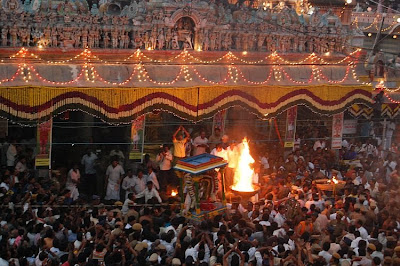Click on all photographs to enlarge
At about


A flame taken from the five earthen pots that were lit just after the early morning temple ceremony of Bharani Deepam is kept burning in the Temple throughout the day as a symbol of the merging of manifestation back into God, the one source of all. This single flame is referred to as the Bharani Deepam. At 10:00 in the morning, a select group of fishermen are blessed by the temple priest with a small ceremony. At this time, amidst ringing bells and temple music, the priest gives the fishermen a lamp that has been lit from the Bharani Deepam in the
Local fishermen are traditionally given the privilege of carrying the Bharani Deepam up the mountain and lighting the Krittika Deepam in the evening, because, according to a popular myth, Parvati (the wife of Lord Siva) was born in a fishing village.

Significance
"There is immense significance in this first Krittika Deepam ceremony called Bharani Deepam. At this time, the universal Lord manifests as the five elements, which will later fully merge to become one when the Krittika Deepam flame is lit in the evening. From one to many and many to one. This is the whole essence of Saivism and the meaning of Krittika Deepam."
All across

Krittika Deepam occurs annually in the lunar month of Kartika, which occurs in November/December, on the last day of the 10-day festival called Brahmotsavam. It is on this auspicious day that, at precisely 6:00 in the evening, a sacred fire is lit on top of the 2,668 foot Arunachala mountain to symbolize the merging of all manifest existence back into the one source of all things. It is said that those who witness this sacred ceremony personally receive the blessings of Siva and Parvati. All of the traditional temple rituals that are performed during Brahmotsavam create a spiritual fervency that culminate with great power on Krittika Deepam as a grand congregation of devotees, holy men, officials, police personnel and media squeeze together, shoulder to shoulder, to witness the festival's magnificent consummation.

Preparations for this holy day begin one month in advance with the local administration, revenue department, police and temple authorities. Since early morning, temple staff and volunteers have been carrying five-gallon containers of ghee and large pots of thick, braided cloth wicks to the top of Arunachala mountain. Once the mountaintop flame has been lit, it must be kept burning for ten days, which requires vast quantities of wick and clarified butter.


miscreants lighting fires for luck (a local superstition)

moon in left corner background
As the day wanes into dusk and night begins to darken the sky, pilgrims stand or sit, motionless with anticipation, at the base of Arunachala mountain, preparing to worship God Siva as an infinite pillar of light.
By 5:00 in the evening, the area surrounding the
Suddenly, the crowd's attention shifts to the
In a few minutes, the next palanquin arrives “Subramanya”. It's a little bigger. Unmindful of its weight, those who are carrying this celestial cargo somehow manage to dance with abandon, rocking the Deity joyously.
Now another palanquin is arriving, rocking to and fro. "Swami, Swami," the crowd shouts. Here, "Swami" is referring to Siva. Amba (Goddess Parvati) is right behind, followed by Chandikeshwara.
Within about 30 minutes, five palanquins have arrived in all their spiritual pageantry.
Finally, the appointed moment arrives. Against the backdrop of a sunset sky, crowned with the rising star of Kartika, thundering firecrackers, ringing

The air is charged as the overpowering sight of light, signifying Siva in the form of Jyoti (divine light), merges with Parvati to become Siva/Sakti. Now, finally, Ardhanarishvara is brought out of the



When that flame is seen by the thousands of devotees below, the entire countryside explodes with flashing luminescence. Bonfires, lamps, neon lights and fireworks light the night like day as a surging, thronging, emotionally charged mass of devotees chant, "Arunachala Siva," "Annamalai” and "Annamalai Harohara”. The sight of the Krittika Deepam is magical. It brings an inexplicable joy. People are ecstatic, mesmerized by the light.

The
Long-time pilgrims assert that, even years later, the very thought of an otherworldly moment like this recreates it, just as if it is happening fresh and new.
[Edited extract from ‘Fire on the Mountain’]





